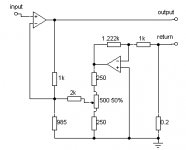Hey guys, sorry I haven't been around. I've been working on other things. One of which is actually a very high performance amplifier circuit which happens to be quite suitable for further versions of the "trans-amp". If you have any questions about the theory behind this or how the hybrid feedback is implemented, please ask.
I've been trying to work out a good kit design but other things have gotten in the way of my progress thus far.
I'm hoping the slow-down of the winter months will help with that!
I'll be releasing kits for the Mark IV amplifier once its board design is complete. This is the only version I'm satisfied with releasing for others to use as I feel the others are inferior especially in terms of susceptibility to layout problems.
Mark III uses a potentiometer to directly control a hybrid feedback loop and this gives numerous problems, the main ones being hum/noise pickup and gain tracking problems due to amplifier input impedance working against the FB network impedance.
Mark IV eliminates all these problems and gives active voltage control over the impedance factor. This means that any input control voltage within the specified range can be used to program the amplifier's output impedance. This also gives the ability to have multiple discrete amplifiers track the same control input.
I'll follow up with more detailed info and a working schematic when I have the time!
I'm hoping the slow-down of the winter months will help with that!
I'll be releasing kits for the Mark IV amplifier once its board design is complete. This is the only version I'm satisfied with releasing for others to use as I feel the others are inferior especially in terms of susceptibility to layout problems.
Mark III uses a potentiometer to directly control a hybrid feedback loop and this gives numerous problems, the main ones being hum/noise pickup and gain tracking problems due to amplifier input impedance working against the FB network impedance.
Mark IV eliminates all these problems and gives active voltage control over the impedance factor. This means that any input control voltage within the specified range can be used to program the amplifier's output impedance. This also gives the ability to have multiple discrete amplifiers track the same control input.
I'll follow up with more detailed info and a working schematic when I have the time!
i found a diagram of how Yamaha implemented variable impedance (but i can no longer find a reference to the model number it was used in, which should be in the DIYaudio archives from about 2007 or 2008). too many websites selling new yamaha equipment to make a google search worthwhile......i tried several different search terms and went through 20 pages for each search phrase.
Attachments
Last edited:
their variable impedance control went from +2 to -2 ohms, but it was only on one or two amplifier models, maybe users found the negative impedance values too unstable, as did ESP Sound. negative impedances tend to oscillate. that's how some oscillators work, is the use of a negative impedance and a reactive component. you might get a lot of good explanation by reading this:
Negative impedance converter - Wikipedia, the free encyclopedia
actually i've seen NICs used in audio to compensate for unexpected loading of preamp outputs.
Negative impedance converter - Wikipedia, the free encyclopedia
actually i've seen NICs used in audio to compensate for unexpected loading of preamp outputs.
i think the point of having the negative part of the range is that you could hypothetically make your speaker wires "disappear" i.e. null out their resistance at the amplifier, to get effectively zero output impedance AT the speaker. so if you had 2 ohms worth of speaker wire (highly unlikely in most home setups), you could compensate for it and maintain a high damping factor right to the speaker box. at least that's the theory. going too far into the negative impedance region would not be good, unless you had a special case of high Q loaded horns or something like that. some high efficiency speakers CAN produce a lot of back EMF, especially pro audio cabinets that have a sensitivity of 100db/1W/1m or more. a lot of those speakers use ferrofluid, which not only dissipates heat (the original reason for using it), but it provides virtual pole pieces that extend across the air gap right up to the surface of the voice coil. this greatly increases the efficiency of the speaker, and also increases the back EMF. such speakers are more in need of a high damping factor, than "dry gap" speakers.
Last edited:
i can see a use for it with some professional situations, for instance a long (50ft or more) set of speaker cables and several speaker cabinets parallel connected to make a 2 ohm load. for a setup like that, i can see a need for a slight negative output impedance, to cancel the resistance of the speaker wires. that is however a somewhat extreme case, and not likely to be something to worry about in a home setup.
And this would only apply if you were absolutely concerned with keeping the electrical damping as high as possible. In most cases an ohm or two (or more) in between amp and speaker isn't going to have a deleterious effect.
This isn't to say that there isn't some use for negative output impedance; I just don't feel it as useful as adjustable positive impedance.
This isn't to say that there isn't some use for negative output impedance; I just don't feel it as useful as adjustable positive impedance.
- Status
- This old topic is closed. If you want to reopen this topic, contact a moderator using the "Report Post" button.
- Home
- Amplifiers
- Solid State
- That curious extra knob, or: "Trans-Amp"
